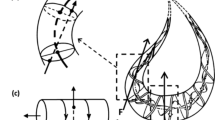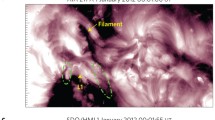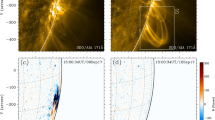Abstract
The formation mechanism of two homologous transequatorial loops (TLs) of July 7–8, 1999 (SOL1999-07-07) is studied. The TLs connected active region AR 8614 from the northern hemisphere to AR 8626 in the southern hemisphere. The first TL appeared as a distinct structure at 12:49 UT on July 7, the second TL appeared at 06:21 UT, on July 8. Important results are obtained in this analysis: (i) The configuration of the two TLs is similar in X-rays. (ii) The sizes of the two active regions related to the TLs increased before and during the formation of the two TLs, this induced the expansion of their coronal loops. (iii) Both TLs formed globally on a time scale shorter than 110 min (time resolution of observations). (iv) An X-shaped coronal structure was observed. This observational evidence suggests that the two TLs formed by the same physical mechanism, magnetic reconnection, between the two expanding magnetic configurations of the two ARs.










Similar content being viewed by others
References
Aschwanden, M.: 2009, Physics of the Solar Corona, Springer, Berlin 691.
Balasubramaniam, K.S., Pevtsov, A.A., Cliver, E.W., Martin, S.F., Panasenco, O.: 2011, Astrophys. J.743, 202.
Bao, S., Zhang, H.: 1998, Astrophys. J.496, L43.
Berger, M.A.: 1999, Plasma Phys. Control. Fusion41, B167.
Canfield, R.C., Hudson, H.S., McKenzie, D.E.: 1999, Geophys. Res. Lett.26, 627.
Chen, J., Bao, S., Zhang, H.: 2006, Solar Phys.235, 281. DOI .
Chen, J., Bao, S., Zhang, H.: 2007, Solar Phys.242, 65. DOI .
Chen, J., Lundstedt, H., Zhang, H.: 2010, Adv. Space Res.45, 537.
Chen, J., Lundstedt, H., Deng, Y., Wintoft, P., Zhang, Y.: 2011, Solar Phys.273, 51. DOI .
Démoulin, P., Berger, M.A.: 2003, Solar Phys.215, 203. DOI .
Doschek, G.A.: 1990, Astrophys. J. Suppl.73, 117.
Du, G.H., Chen, Y., Zhu, C.M., Liu, C., Ge, L.L., et al.: 2018, Astrophys. J.860, 40.
Fárnik, M., Karlicky, M., Svestka, Z.: 1999, Solar Phys.187, 33. DOI .
Hao, J., Zhang, M.: 2011, Astrophys. J. Lett.733, 27L.
Khan, J., Hudson, H.: 2000, Geophys. Res. Lett.27, 1083.
Liu, J., Zhang, H.: 2006, Solar Phys.234, 21. DOI .
Luoni, M.L., Démoulin, P., Mandrini, C.H., van Driel-Gesztelyi, L.: 2011, Solar Phys.270, 45. DOI .
Moon, Y.J., Choe, G.S., Park, Y.D., Wang, H., Gallagher, P.T., Chae, J., Yun, H.S., Goode, P.R.: 2002, Astrophys. J.574, 434.
Pevtsov, A.: 2000, Astrophys. J.531, 553.
Pevtsov, A.A.: 2004, Transequatorial connections: Loops or magnetic separators? In: Stepanov, A.V., Benevolenskaya, E.E., Kosovichev, A.G. (eds.) Multi-Wavelength Investigations of Solar Activity, Proceedings of IAU Symposium223, Cambridge University Press, Cambridge, 521.
Pevtsov, A., Canfield, R.C., Metcalf, T.R.: 1994, Astrophys. J.425, L117.
Pevtsov, A., Canfield, R.C., Metcalf, T.R.: 1995, Astrophys. J.440, L109.
Poisson, M., Démoulin, P., López Fuentes, M., Mandrini, C.H.: 2016, Solar Phys.291, 1625. DOI .
Rust, D.M., Kumar, A.: 1996, Astrophys. J.464, L199.
Scherrer, P.H., Bogart, R.S., Bush, R.I., Hoeksema, J.T., Kosovichev, A.G., Schou, J.: 1995, Solar Phys.162, 129. DOI .
Švestka, Z., Krieger, A.S., Chase, R.C., Howard, R.: 1977, Solar Phys.52, 69. DOI .
Tsuneta, S.: 1991, Solar Phys.136, 37. DOI .
Tsuneta, S.: 1996, Astrophys. J.456, L63.
Wang, J.X., Zhang, Y.Z., Zhou, G.P., Harra, L.K., Williams, D.R., Jiang, Y.C.: 2007, Solar Phys.244, 75. DOI .
Xu, H., Gao, Y., Popova, E.P., Nefedov, S.N., Zhang, H., Sokoloff, D.D.: 2009, Astron. Rep.53, 160.
Yang, S., Büchner, J., Zhang, H.: 2009, Astrophys. J.695, L25.
Yokoyama, M., Masuda, S.: 2009, Solar Phys.254, 285. DOI .
Yokoyama, M., Masuda, S.: 2010, Solar Phys.263, 135. DOI .
Zhang, Y., Wang, J., Attrill, G.D.R., Harra, L.K., Yang, Z., He, X.: 2007, Solar Phys.241, 329. DOI .
Zhang, Q.M., et al.: 2016, Astrophys. J.827, 27.
Zhou, G., Wang, J., Zhang, J.: 2006, Astron. Astrophys.445, 1133.
Acknowledgements
The Yohkoh mission was developed and launched by ISAS/JAXA, Japan, with NASA and SERC/PPARC (UK) as international partners. This work made use of the Yohkoh Legacy Archive at Montana State University, which is supported by NASA. SOHO is a project of international cooperation between ESA and NASA. This work was partly supported by National Natural Science Foundation of China (grant nrs. 11711530206, 11303048, 11427901, 11673033, 11773038, U1731241). Jie Chen thanks for financial support from China Scholarship Council and Key Laboratory of Dark Matter and Space Astronomy, CAS. The authors also thank the Royal Society for the support to conduct this research. JC and RE acknowledges the Science and Technology Facilities Council (STFC, grant numbers ST/M000826/1, ST/L006316/1). This work is also partly supported by the Strategic Priority Research Program on Space Science, the Chinese Academy of Sciences (Grant No. XDA15320302, XDA15052200, XDA15320102). We thank the referee, who provided very considerable suggestions.
Author information
Authors and Affiliations
Corresponding author
Ethics declarations
Disclosure of Potential Conflicts of Interest
The authors declare that they have no conflicts of interest.
Additional information
Publisher’s Note
Springer Nature remains neutral with regard to jurisdictional claims in published maps and institutional affiliations.
Electronic Supplementary Material
Below is the link to the electronic supplementary material.
Rights and permissions
About this article
Cite this article
Chen, J., Pevtsov, A.A., Su, J. et al. Formation of Two Homologous Transequatorial Loops. Sol Phys 295, 59 (2020). https://doi.org/10.1007/s11207-020-01625-z
Received:
Accepted:
Published:
DOI: https://doi.org/10.1007/s11207-020-01625-z




